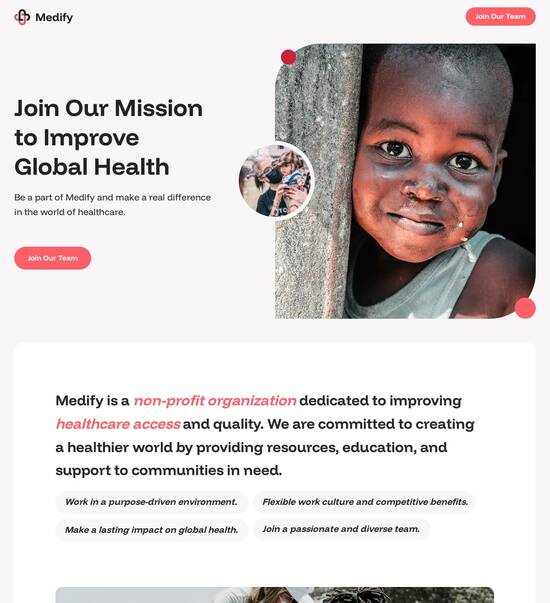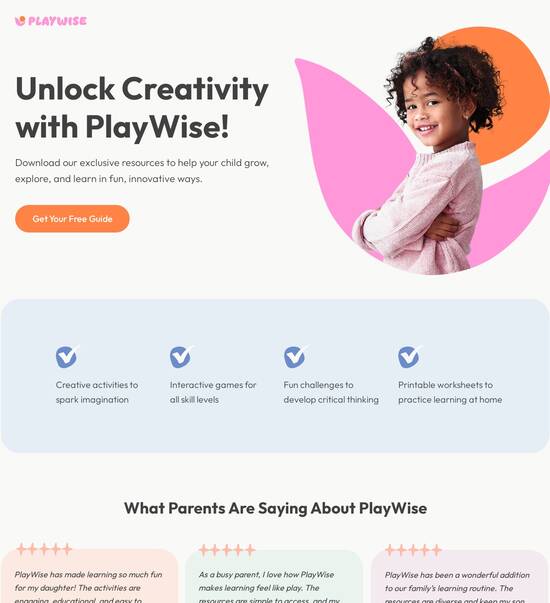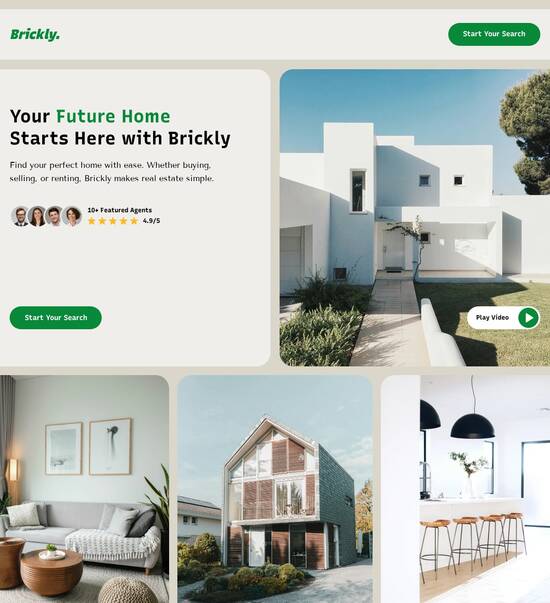
HTML/CSS optimized privacy policy page template
Explore Similar TemplatesAbout template
Supercharge your privacy policy page with HTML/CSS for outstanding performance! Learn more today.
Recommended templates

Easy to build without coding
With the intuitive drag-and-drop builder, anyone on your team can create high-converting pages without any knowledge of code or design. Make enhancements to your landing page with custom widgets using Javascript, HTML/CSS, or third-party scripts.

Multiple layouts for any industry and goal
Select from 500+ landing page layouts built to boost conversions across industry-specific scenarios. Customize them by adjusting fonts, adding images, and generating on-brand content with the AI assistant. Quickly scale with Instablocks® and Global Blocks that you can save, reuse, and update globally.

Loads fast and looks polished on any device
Every template is responsive, which means they present professionally on any device and load blazingly fast with our Thor Render Engine. You can also power them up with Google AMP technology to deliver an unparalleled mobile experience and drive higher conversions.

Robust analytics & experimentation
Get real-time updates and reporting across all your devices, showing the number of visitors, conversions, cost-per-visitor, and cost-per-lead. Launch AI-powered experiments, run A/B tests, and use heatmaps to analyze user behavior, then optimize your landing page to maximize conversions.







Easy to build without coding
With the intuitive drag-and-drop builder, anyone on your team can create high-converting pages without any knowledge of code or design. Make enhancements to your landing page with custom widgets using Javascript, HTML/CSS, or third-party scripts.
Multiple layouts for any industry and goal
Select from 500+ landing page layouts built to boost conversions across industry-specific scenarios. Customize them by adjusting fonts, adding images, and generating on-brand content with the AI assistant. Quickly scale with Instablocks® and Global Blocks that you can save, reuse, and update globally.
Loads fast and looks polished on any device
Every template is responsive, which means they present professionally on any device and load blazingly fast with our Thor Render Engine.
Robust analytics & experimentation
Get real-time updates and reporting across all your devices, showing the number of visitors, conversions, cost-per-visitor, and cost-per-lead. Launch AI-powered experiments, run A/B tests, and use heatmaps to analyze user behavior, then optimize your landing page to maximize conversions.
All the features you need to build privacy policy example
Explore more featuresLearn how to build privacy policy pdf free download
Frequently asked questions about privacy policy of a company
Leading the way in building high-performing landing pages





Privacy policy page template html css: Your ultimate how-to guide
Instapage is the most powerful landing page and conversion rate optimization (CRO) platform designed for marketers in the USA. This guide will show you how to leverage its capabilities to build impactful landing pages that maximize your digital marketing ROI.
Understanding the importance of landing pages
Landing pages are a critical component of any successful marketing campaign. They serve as dedicated sites that focus on a particular product or service, often used in conjunction with ads on social media or search engines. Gain insight into why an optimized landing page is essential for campaign success and user conversion.
- Drive more targeted traffic: A well-crafted landing page targets specific audience segments and drives qualified leads.
- Increase conversion rates: Optimized landing pages enhance the user experience, leading to higher conversion rates.
- Measure performance effectively: With Instapage's detailed analytics, track the efficiency of your landing pages to refine your strategies.
Creating your first landing page with Instapage
Follow these steps to get started on building a high-converting landing page:
- Choose a template: Browse through over 100 high-converting templates and select one that aligns with your goal.
- Customize your design: Use intuitive drag-and-drop features to customize elements, ensuring your landing page fits your brand’s aesthetics.
- Set up lead generation: Incorporate lead generation elements like forms and calls-to-action to streamline the collection of visitor information.
Optimizing for conversions
After creating your landing page, it's time to optimize it:
- Utilize A/B testing: Run A/B tests to explore different headlines, images, and calls-to-action to discover what resonates best with your audience.
- Analyze heatmaps: Use heatmaps to gain insights into where visitors focus their attention, allowing for further refinements.
- Implement personalization features: Use dynamic text replacement to tailor content for specific audience segments, boosting engagement.
By following these steps and using Instapage's inherent features, your landing page will not only attract attention but also convert visitors into leads.
For marketers in the USA looking to increase their conversion rates, Instapage is a top-tier choice, combining power with usability.
Ready to optimize your digital marketing campaigns? Sign up for Instapage today and start creating landing pages that deliver results!
People also ask about HTML/CSS optimized privacy policy page template
HTML/CSS optimized privacy policy page template
Unveiling the HTML/CSS optimized privacy policy page template
As privacy concerns continue to grow, businesses need to present clear privacy policies that encourage trust and transparency. A well-structured privacy policy not only informs users about how their data is handled but also complies with ever-evolving legal requirements. An optimized HTML/CSS privacy policy page template is essential for businesses looking to meet these demands while providing an exceptional user experience.
The necessity of a well-structured privacy policy
Understanding the concept of privacy policies is crucial for any online service. A privacy policy outlines how a business collects, uses, and protects user data. It is not only a legal requirement in many jurisdictions, but it serves to establish a framework within which users can be confident their personal information is safeguarded. Essential components include detailed explanations of data types collected, the purpose of data collection, and the rights individuals have regarding their data.
One of the most significant reasons for maintaining a clear and straightforward privacy policy is to build customer trust. Users today are increasingly aware of privacy issues, and transparency about data handling fosters confidence. When users know how their information will be treated, they are more likely to engage with a brand, exploring its services without the worry of misuse.
Key features of the HTML/CSS privacy policy page template
An effective HTML/CSS privacy policy page template should offer customizable design elements. Businesses want the freedom to personalize the layout to reflect their branding. The user-friendly HTML structure allows for easy modifications, while CSS styles ensure a responsive and visually appealing presentation across different devices. This means users get a uniform experience regardless of how they access the page.
Intuitive content sections within the template are also vital. The types of personal information—like name, contact details, and IP addresses—should be clearly delineated. It is equally important to specify data collection methods, such as cookies and web beacons, so users are fully aware of how their data is acquired and utilized. This clarity can significantly reduce confusion and increase user trust.
Additionally, any effective privacy policy page must comply with local and international regulations such as GDPR and CCPA. A well-crafted template should feature dynamic updates that accommodate changing legal standards, ensuring users are always informed and protected.
Technical considerations for optimal performance
Cross-browser compatibility is a cornerstone of any successful web page. Ensuring the privacy policy template functions seamlessly on various browsers, including Chrome, Firefox, and Safari, is crucial. Businesses should conduct thorough testing to guarantee a consistent user experience across both computers and mobile devices. This level of attention to detail makes sure no potential customer is left with a negative experience due to technical issues.
Given the rise in mobile device usage, mobile responsiveness is equally essential. Implementing a mobile-optimized design ensures content is easily readable and navigatable on smaller screens. Techniques such as using flexible layouts, larger font sizes, and touch-friendly buttons make a significant difference. By prioritizing mobile usability, businesses can capture a crucial segment of their audience effectively.
Enhancing user engagement through effective design
Utilizing visual hierarchy in the layout of the privacy policy is key to capturing user attention. Strategic arrangement of content can guide readers through essential points, while using headings, bullet points, and whitespace enhances readability. Bullet points, in particular, allow users to skim through important information quickly, making policies more approachable.
Incorporating interactive elements further enhances user engagement. Tools, such as toggles for revealing or obscuring detailed information, allow users to control their reading experience. Additionally, FAQs addressing common privacy-related queries can expedite the information-gathering process for users, showcasing the brand’s commitment to transparency and responsiveness.
The role of data transparency in customer relations
Clarifying how customer data is used and retained is fundamental to establishing trust. A well-designed privacy policy delineates specific applications of user information, such as personalization of services or marketing efforts. Being transparent about data retention periods for different types of information shows commitment to ethical management practices.
Moreover, enabling users to control their data can significantly improve user relationships. Features allowing customers to update or delete their information demonstrate a brand’s accountability. Providing an easily comprehensible overview of user rights in relation to their data helps in clarifying doubts and reinforcing trust.
Building a trustworthy image for your website
Examining case studies of businesses that have successfully implemented optimized privacy policy templates reveals significant benefits. Companies that prioritize clear and concise privacy statements report increased levels of user trust and engagement. Feedback mechanisms can be employed to gauge customer sentiments, often showcasing a marked improvement in customer confidence following updates to privacy policies.
Quantifying the impact on conversions is another advantage of a strong privacy policy. Businesses analyzing data before and after policy implementations often discover a positive correlation between clear privacy guidelines and customer retention. Increased trust leads to higher conversion rates, transforming casual visitors into loyal customers.
Continued adaptation and improvement
To keep pace with changing laws and user expectations, it is essential to implement data collection and usage analytics. Monitoring how users interact with the privacy policy page can yield insights into areas for improvement. Businesses should utilize tools to gather feedback, allowing for ongoing optimization based on these analytics. This proactive approach can help ensure that privacy policies remain relevant and user-friendly.
Version control is equally important for maintaining compliance. Establishing a schedule for regular reviews and updates of the privacy policy is crucial. By being diligent in these practices, organizations can adapt to evolving regulations and maintain a strong reputation for accountability in their data protection efforts.
Conclusion: the future of privacy policy pages
Emerging trends in user privacy and data protection signal a strong shift toward greater transparency in the digital landscape. As users become more educated about their rights, the expectations for businesses to comply with these standards will only increase. The role of well-designed privacy policy templates in addressing these trends cannot be overstated, providing a foundation for clear communication about data practices.
The ongoing evolution of privacy policies will further shape industry standards, compelling businesses to provide not just legal jargon, but genuine, user-friendly experiences. In doing so, they meet both user expectations and regulatory requirements, significantly enhancing the user experience and building a trustworthy digital environment.
Ready to skyrocket conversions?
Supercharge your ad campaigns with high-performing landing pages
Get started














